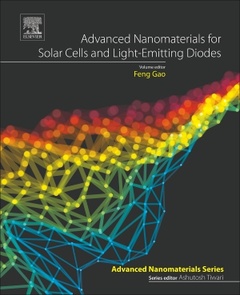Description
Advanced Nanomaterials for Solar Cells and Light Emitting Diodes
Micro and Nano Technologies Series
Coordinator: Gao Feng
Language: English
Subject for Advanced Nanomaterials for Solar Cells and Light...:
549 p. · 19x23.3 cm · Paperback
Description
/li>Contents
/li>Readership
/li>Biography
/li>Comment
/li>
Advanced Nanomaterials for Solar Cells and Light Emitting Diodes discusses the importance of nanomaterials as the active layers in solar cells and light emitting diodes (LEDs), along with the progress of nanomaterials as the electron and hole transporting layers.
Specifically, the book reviews the use of nano-morphology of polymers, small molecules, and the organic-inorganic perovskites as the active layers in solar cells and LEDs. The design, fabrication and properties of metal-oxide-based nano-structures as electron and hole transporting layers are also reviewed. In addition, the development of plasmonic nanomaterials for solar cells and LEDs is discussed. Each topic in this book includes an overview of the materials system from principles to process. The advantages, disadvantages and related methodologies are highlighted. The book includes applications based on materials and emphasize how to improve the performance of solar cells and LEDs by the materials design, with a focus on nanomaterials.
2. Nanostructure of Organic Solar Cells
3. Nanomaterials in Dye-Sensitized Solar Cells
4. Solution-Processed Crystalline Silicon Heterojunction Solar Cells
5. Perovskite Solar Cells Processed by Solution Nanotechnology
6. Solar Cells Based on Hot Carriers and Quantum Dots
7. LEDs Based on Small Molecules
8. Bulk- and Nanocrystalline-Halide Perovskite Light-Emitting Diodes
9. Polymer Light-Emitting Diodes
10. Nanomaterials for Polymer and Perovskite Light-Emitting Diodes
11. Preparation and Characterization of Oxide/Semiconductor Interfaces
12. Highly Conductive Nanocomposites Based on Doped Metal Oxides as Interlayer Materials for Organic/Polymer Solar Cells
13. Nanostructures for Plasmonic Effects in Solar Cells and LEDs
academic and industry researchers in the fields of materials science, nanotechnology, renewable energy
- Provides latest research on nanostructured materials including small molecules, polymers, organic-inorganic perovskites, and many other relevant materials systems for solar cells and LEDs
- Addresses each promising materials system from principles to process, detailing the advantages and disadvantages of the most relevant methods of processing and fabrication
- Looks ahead to most likely techniques to improve performance of solar cells and light emitting diodes




